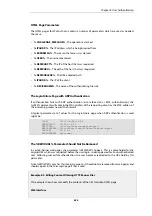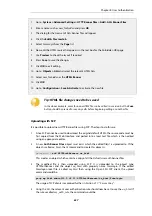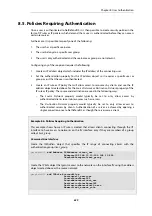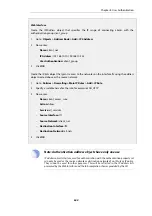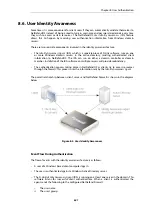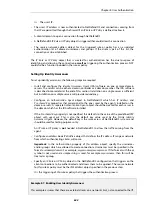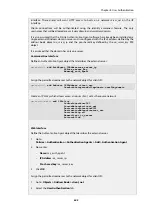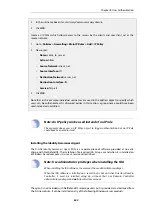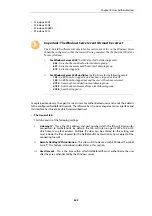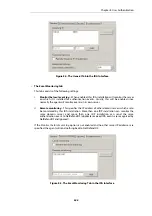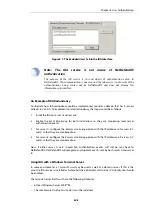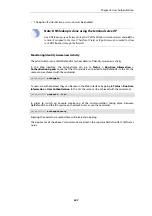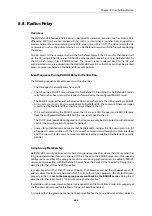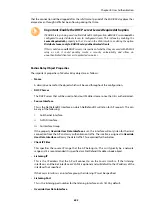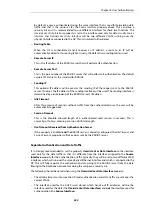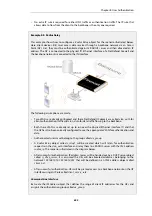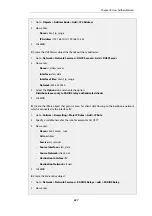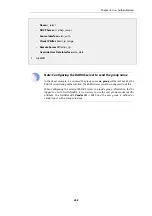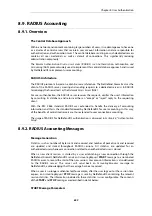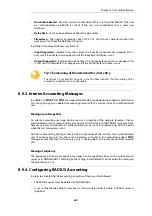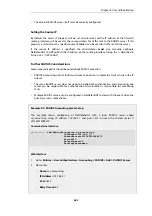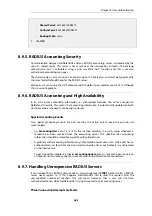
8.7. Multi Factor Authentication
When access to resources located behind a NetDefend Firewall is based on credentials, the
security can be further strengthened by using
Multi Factor Authentication
. This is sometimes
referred to as
2-factor authentication
or
2-step authentication
. The first factor is usually a
username/password combination. A second factor is typically a one-time code which might be
sent to the user at the time of the login via SMS or e-mail, or might be generated in some way by
the user themselves (for example with a code-box).
Multi Factor Support is Automatic
By default, NetDefendOS provides support for multi factor authentication by being able to
recognize a RADIUS
Access-Challenge
message and displaying a special webpage to request the
additional code. This webpage has the NetDefendOS
Banner File
name
LoginChallenge
.
Mobile VPN IPsec clients are also supported by multi-factor authentication when using the
following authentication methods:
•
IKEv1 with XAuth.
•
IKEv2 with EAP.
Multi Factor Processing Sequence
The sequence of processing for multi factor authentication with NetDefendOS is as follows:
1.
Authentication is set up as normal using an authentication rule and IP rules (or IP policies).
2.
The authentication source will be an external RADIUS server that has been configured to
perform multi factor authentication.
3.
A user tries to access resources through the NetDefend Firewall. They are presented with a
standard NetDefendOS login challenge page and they enter their credentials.
4.
NetDefendOS now sends these credentials to the RADIUS server for authentication in a
RADIUS
Access-Request
message.
5.
In multi factor authentication, the RADIUS server will do two things:
i.
It informs NetDefendOS that multi factor authentication must be used by sending back
a RADIUS
Access-Challenge
message.
ii.
Depending on the type of the additional challenge, the server might also cause a
one-time code to be sent to the user. For example, this might be in an SMS message to
a mobile device. Alternatively, the code might be generated by the user themselves
using, for example, a code box.
6.
The user enters the code they receive or generate and NetDefendOS relays the entered
code to the RADIUS server in another
Access-Request
message.
7.
The RADIUS server verifies the code. If the user is authenticated then an
Access-Accept
is sent
back to NetDefendOS and the client is given access to protected resources. If it is not
verfied, the server sends back an
Access-Reject
message to NetDefendOS and access is
denied.
Notes on Multi Factor Authentciation
Chapter 8: User Authentication
650
Summary of Contents for NetDefendOS
Page 30: ...Figure 1 3 Packet Flow Schematic Part III Chapter 1 NetDefendOS Overview 30 ...
Page 32: ...Chapter 1 NetDefendOS Overview 32 ...
Page 144: ...Chapter 2 Management and Maintenance 144 ...
Page 284: ...Chapter 3 Fundamentals 284 ...
Page 392: ...Chapter 4 Routing 392 ...
Page 419: ... Host 2001 DB8 1 MAC 00 90 12 13 14 15 5 Click OK Chapter 5 DHCP Services 419 ...
Page 420: ...Chapter 5 DHCP Services 420 ...
Page 573: ...Chapter 6 Security Mechanisms 573 ...
Page 607: ...Chapter 7 Address Translation 607 ...
Page 666: ...Chapter 8 User Authentication 666 ...
Page 775: ...Chapter 9 VPN 775 ...
Page 819: ...Chapter 10 Traffic Management 819 ...
Page 842: ...Chapter 11 High Availability 842 ...
Page 866: ...Default Enabled Chapter 13 Advanced Settings 866 ...
Page 879: ...Chapter 13 Advanced Settings 879 ...

